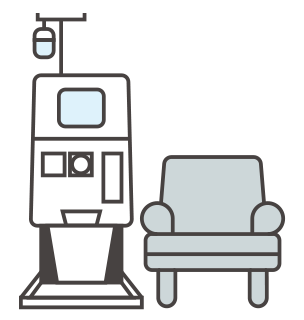Why home dialysis?
Flexibility
Enjoy normalcy of schedule and lifestyle despite dialysis
Friends & Family
Be present for important milestones and daily moments
Feeling better
More energy, less time to recovery, fewer medications
You have options
Home Hemodialysis
Home hemodialysis (HHD) is an alternative to in-center dialysis for people who want control over their time and treatment. Many dialysis clinics offer HHD training and support for patients and caregivers. You have multiple options for machines to use, with different features and benefits.
Like in-center dialysis, you’ll be connected to the machine via your dialysis access, which filters your blood through a dialyzer to remove toxins, waste, and excess fluid, then returns clean blood to you.
Key considerations:
- Home dialysis clinic
- Training for home
- Care partner
- Cannulation
- Readying your home
- Professional goals
- Schedule flexibility
- Independence
- Quality of life

Peritoneal Dialysis
Peritoneal dialysis (PD) is an alternative to in-center dialysis and hemodialysis. PD is typically performed in the home, with training and support from your dialysis clinic. Different from hemodialysis, peritoneal dialysis filters the blood by pumping dialysate into your peritoneal (abdominal) cavity, where it absorbs toxins and waste over the course of several hours, before being drained out and discarded.
Key considerations:
- Home dialysis clinic
- Training for home
- Clinical goals
- Time treating
- Readying your home
- Infection control
- Physical intimacy

In-Center Dialysis
In-center dialysis treatments take place at a specialized facility where you have a set time for treatment 3 times per week. Trained healthcare providers will take charge of you and will administer your treatment, typically using high-flow dialysis machines designed for professionals.
You’ll be connected to the machine via your dialysis access, which filters your blood through a dialyzer to remove toxins, waste, and excess fluid, then returns clean blood to you.
Key considerations:
- Location
- Transportation
- Scheduling
- Safety & exposure
- Contingency planning
- Emotional toll
- Staffing
- Machine options
See more data
Ask the experts
Interested in home dialysis with Tablo?
The Tablo Hemodialysis System is available for use both in-center and at home, through your provider. By filling out this form and providing us your information, you agree to our Privacy Policy.
Outset Medical is passionate about dialysis patients knowing their options and living their best life. This material is not intended to provide or be a substitute for professional medical advice, diagnosis or treatment. The reported benefits of a particular dialysis therapy may not be experienced by all patients. It is important that patients consult with their physician to understand the risks and responsibilities associated with a particular dialysis therapy prior to receiving treatment, and that they rely on their physician’s judgment. Only a physician can determine whether a patient is a suitable candidate for a particular dialysis therapy based on the individual facts and circumstances of the patient.








